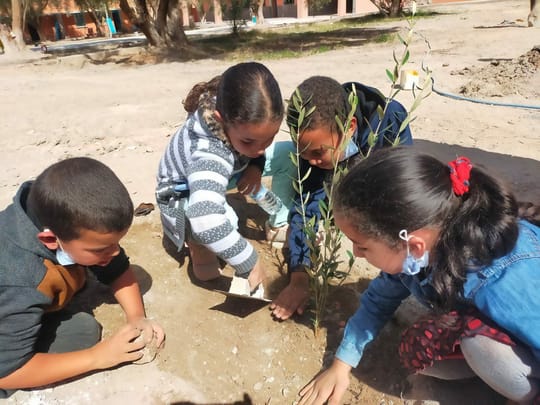Ibn Khaldoun, the Memory of Ouijjane

By Omaima Khalil El Fanne, Dakira Cultural Coordinator

Students of Ibn Khaldoun primary school are planting olive trees. Photo taken 28 February,2022 by Omaima Khalil ELFANNE.
Ibn Khaldoun isan army base that was restored in 1953 as an agricultural school by Mrs. Morice and her husband, a French couple. They made a school there, rehabilitated two classes, and then started to teach the children of Ouijjane the French language.
The school was named after the Arab sociologist Ibn Khaldoun and is considered a memory of Ouijjane, given its historical value in the history of Morocco. Within the Dakira Program, and in order to preserve this local heritage of the commune of Ouijjane, the High Atlas Foundation has decided to revive this historical monument and share its history with the students of the school.
On February 28, 2022, Jamal and Omaima Khalil, two field coordinators of the Dakira program, implemented a planting activity in the Ibn Khaldoun school, along with other cultural activities, to help students learn the history of their school.

Students of Ibn Khaldoun primary school with HAF Fields coordinators. Photo taken 28 February, 2022 by Abdelghani Kastih.
They met 57 students in Ibn Khaldoun , approaching them first with a balloon activity to introduce everyone to each other and then an icebreaker activity with them to familiarize themselves more. Then, they presented the purpose of their visit and the planting activity before asking them some questions to understand the level of knowledge they had of the history of their school. This interactive activity was done with the help of color-coded cards for students to hold up. Right after, with the help of the school teachers,the team members started to share the history of this school with students as well as a historical overview of Ouijjane.

Cultural and environmental activities in Ibn Khaldoun primary school. Photo taken 28 February, 2022 by Abdelghani Kastih.
Afterwards, there was a small workshop on climate change, explaining how trees promote the reduction of the greenhouse gasses that cause this change, as well as on the environmental, social, economic, religious and cultural value of the tree. When asked about the importance of planting trees, all the students agreed that human beings need trees to survive and that trees play a vital role in our lives by providing us with oxygen and removing pollutants from the air, not only helping us stay physically healthy but also helping to reduce stress and improve our mental health. Lastly, the group discussed how the tree has always been a sign of peace and tolerance and coexistence of all peoples.
The students were very enthusiastic and motivated to participate in the planting. They listened attentively to the explanation of the tree-planting procedure and then helped to implement it. This was the first time the students had heard about the history of their school as well as climate change and the importance of protecting the cultural environment and the benefits of trees.

Planting activity with the students of Ibn Khaldoun primary school. Photo taken 28 February, 2022 by Abdelghani Kastih.
Given that the main economic activity of the Ouijjane community is agriculture, the hidden link between nature, culture, and identity, with Ouijjane bring a place of coexistence of several communities (Muslim, Jewish, and Christian) was a natural connection to show.
Students also learned how certain trees symbolize the same concepts for different people, regardless of their nation, culture, or religion, such as the olive tree symbolizing peace and the cedar symbolizing greatness. USAID’s Dakira program aims to discover and explore the power of a tree to bring people together around the same idea.
During the conversation, the students offered to do such initiatives again as well as research the history of Ouijjane and ask their teachers and families to share stories of Ouijjane with them, as their curiosity was aroused. The curiosity of one student pushed her to say, “I want to visit a museum, and I want to discover more about my Douar (Agadir Ouijjane), and all the existing monuments.” All the students shared this proposal and they asked to organize exploration outings and to open up to more historical places in the region.
This article was completed with the support of the United States Agency for International Development (USAID) Dakira Program, and the High Atlas Foundation is solely responsible for its content, which does not necessarily reflect the views of the USAID or the Government of the United States.